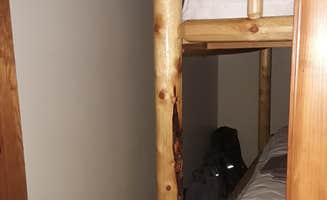Dispersed camping options near Mount Vernon, Oregon offer free alternatives to established campgrounds within the Malheur National Forest. This high desert region sits at approximately 4,700 feet elevation, featuring dramatic temperature swings between day and night even during summer months. Most dispersed sites allow for 14-day stays and require campers to pack out all waste.
What to do
Fly fishing opportunities: The John Day River running alongside Clyde Holliday State Recreation Site Campground provides accessible fishing spots. "The John Day River with a nice little nature path" offers easy water access according to camper Nancy M. The river contains numerous fishing holes suitable for beginners and experienced anglers alike.
Explore local history: Visit the abandoned lumber mill site at Bates State Park Campground to learn about Oregon's logging past. "There are very interesting signs telling about the logging history of the area as well as a playground and nature trails," reports Andrew T. The former mill town once housed 400 residents and retains historical markers throughout its 130+ acres.
Wildlife observation: Several campgrounds offer wildlife viewing opportunities directly from campsites. One camper at Slide Creek Campground noted, "It's gorgeous and the creek is just a few feet to go get water for animals and your fire pits and to put your feet in." Morning and evening hours provide the best wildlife spotting conditions when temperatures are cooler.
What campers like
Spacious camping areas: Middle Fork campground offers generously sized sites far from neighboring campers. "The sites are very spacious and you are far from your neighbors," writes Judy T. This smaller USFS campground provides privacy not found at more developed sites.
Clean facilities: Despite being primitive campgrounds, many locations maintain exceptionally clean restrooms. At Ukiah-Dale Forest State Scenic Corridor, "the bathroom has automatic lights and electric outlets and is kept very clean," according to Dani K. Most state park facilities feature regular maintenance schedules throughout peak season.
Water features: Creeks, rivers, and lakes create natural attractions at nearly every camping location. At Unity Lake State Recreation Site Campground, campers enjoy direct lake access: "We camped right next to lake. We enjoyed a beautiful sunset while sitting around campfires," reports J.P., highlighting the natural swimming opportunities available during summer months.
What you should know
Seasonal operation: Most primitive campgrounds operate seasonally from May through October. Wetmore Campground follows this pattern with limited access during shoulder seasons. "Super beautiful and well kept. We came in the summer and ran into no issues finding an open site," notes camper Mia, though availability changes dramatically during peak periods.
Limited amenities: Pack accordingly for basic facilities at most locations. "No hookups, nice day use area, nice short trails, and local history of the site," explains Cliff at Bates State Park, where services are minimal. Most primitive sites lack trash collection, requiring visitors to pack out all waste.
Road noise: Some campgrounds sit close to highways, creating potential noise issues. One camper at Clyde Holliday noted "Site #25 backed up to hwy 26; daytime passing vehicle noise could be loud. Night vehicle noise wasn't an issue." Request sites furthest from roadways when possible for quieter camping experiences.
Tips for camping with families
Water play options: Children enjoy wading in shallow creek areas during summer months. At Clyde Holliday, Eric L. observed "a nice walking path next to a creek that some children were playing in." These natural water features provide cooling entertainment during hot afternoons when temperatures regularly exceed 90°F.
Wildlife viewing: Morning walks often yield wildlife sightings for kids to enjoy. "We saw several deer there when we arrived," notes Kelly P. about Dixie Campground, making wildlife spotting a natural activity requiring no additional equipment.
Alternative glamping accommodations: For families seeking more comfort than tent camping near Mount Vernon, Oregon, consider the cabin at Deer Creek Guard Station. "Clean, well maintained, cooking supplies provided, heated house with fridge. Outhouse was clean," reports Brittney J., though she recommends "bring your own light, the lanterns did not provide a lot of light and your own blanket for the beds."
Tips from RVers
Site selection: When choosing RV spots, consider pad conditions and hookup availability. At Grant County RV Park, "Spaces were all level and gravel with full hook-ups (20/30/50 amp)," notes Lee D. Most sites accommodate smaller RVs, though larger rigs may find limited options.
Seasonal considerations: RVers report less crowded conditions during shoulder seasons. "We were able to fit into the sites in our 26ft class c," mentions Laura M. about Wetmore Campground, with most locations accommodating medium-sized vehicles without reservation during weekdays.
Utility information: Many campgrounds offer only partial hookups or none at all. At Unity Lake, Ron found "paved sites, room between neighbors, elec hookup and water for our RV, and there's a dump station, A full cell signal too." Document available utilities before arrival as services vary significantly between locations.


